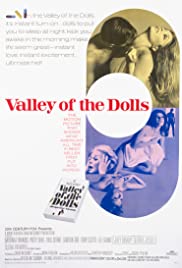
VALLEY OF THE DOLLS
US, 1968, 121 minutes, Colour.
Barbara Parkins, Sharon Tate, Patty Duke, Paul Burke, Susan Hayward, Lee Grant.
Directed by Mark Robson.
Valley of the Dolls was a big bad best-seller which topped the lists in the United States and proved once again that the extravagantly exciting sensation sells well. Jacqueline Susann, the author, became wealthy and a public celebrity and then wrote another best-seller, The Love Machine, also filmed as Once is Not Enough. However, the film version of Valley of the Dolls is not entirely without merit. A lot of the sensation had to go for screen presentation. What remains is an interesting enough story of three girls who, at some stage, resort to pills because of failure, illness or escape. While cliches abound, something of value comes through in part. Barbara Parkins is either quite a good actress or one of those people, like Kim Novak, speak in a genteel way and give an impression of style until you have seen them often enough.
Sharon Tate does not need style in her role and her mirror tragic suicide is hard to take, although feminine sensibilities may give rise to tears. Patty Duke plays a very unsympathetic role and makes it interesting. Susan Hayward appears briefly but tellingly as a veteran, hard-as-nails actress. It is ironic that Judy Garland, who died from an overdose of pills, was originally to play this role.
In 1999, a very benign biopic appeared with Bette Midler as Jacqueline Susann, Isn't She Great.
1. Was this just a sensational film made from a big sensational novel or was there a feeling for human beings pervading it?
2. How real do you think the film was. or is it a journalist's or gossip columnist's view of Hollywood and its people?
3. What did it show of the Hollywood world - harsh, a jungle, the need to fight for survival. people cruel and ruthless?
4. How did Helen Wilson embody much of what the film was about - star quality, but jealous, arrogant, ruthless, over-bearing to her agent, ageing? What impression did she make as she proudly walked out of the party without her wig?
5. The film focussed attention on three girls:
a) Barbara Parkins: innocent, her manner of acting and speaking as a small-town girl, her horror and disedification at the intricacies and intrigues of city life and the lawyer's office. her sophistication, life with the author. her help towards others. her interlude on commercials. Why did she grow jealous towards the end and use pills? Was her scene on the beach credible or moving?
b) Sharon Tate: sex-figure, brainless, her marriage and sacrifices for her husband (why was his agent-sister so jealous?), her getting money for the hospital, her nudie films - was this credible? Her illness and suicide? Was her suicide made to appear realistic or courageous or glamorous (the looking into the mirror and the music)?
c) Patty Duke: a nice girl who ruined herself. Her simplicity, being victimised, ambition, career, hard work, self-love, arrogance, awards, money and style. her marriage (devoted husband), her temperament, instability, meanness, rejection of her husband, the quality of her second marriage, her loss of self-respect, her lack of star quality for survival and, therefore, the substitute of drugs, necessity for work, her addiction, breakdown, the severity of the treatment, yet she remained ultimately mean, trying to steal her friend's husband, her squalid visits to the bar, ending as nothing.
6. What lesson did the film offer? What impact did it finally have, especially about life and the escape and effect of drugs?